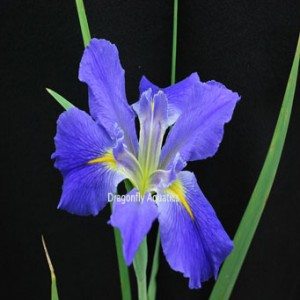 All irises will perform well if they are given at least six hours of sunlight. Most irises will not flower if the sunlight drops to less than four hours a day. If you do plant an iris in a partially shaded area of your pond the best sunlight is that of the morning rather than the afternoon sun. This will help evaporate the dew from the leaves preventing the risk of fungus or bacteria. If given too much afternoon sun it can burn up the petals of the lighter irises.
All irises will perform well if they are given at least six hours of sunlight. Most irises will not flower if the sunlight drops to less than four hours a day. If you do plant an iris in a partially shaded area of your pond the best sunlight is that of the morning rather than the afternoon sun. This will help evaporate the dew from the leaves preventing the risk of fungus or bacteria. If given too much afternoon sun it can burn up the petals of the lighter irises.
When you first plant a young iris they require less water until they become established, moist soil, little to no water above the soil line. Since an iris is considered a marginal pond plant it is best to plant around the perimeter of your pond or bog area. Most iris will tolerate a range of water depths from moist soil to a few inches of water over their crown once they have become established water plants. Just make sure the crown of the iris always remains moist or in the water. The water garden irises benefit greatly from early spring fertilizer and fertilizing throughout the growing season. You should begin fertilizing irises when the pond temperature reaches 65 degrees and continue to feed them once a month through the growing season, well after they begin to sprout. You can stop fertilizing them about a month before the last frost free date in your area. This will allow the iris to harden off for the winter. If you have no frost in your area stop fertilizing when the plant begins to show signs of going dormant. This would be when the leaves begin to brown and new growth has stopped.
Depending on the iris you have determines the winter care for it. Once the foliage dies back and the water temperatures begin to cool down you can trim the leaves back to about an inch or two above the crown of the plant. You want to make sure they will stay wet throughout the winter. They do best just by leaving them on the shelf of your pond or marginal area of your pond. The main goal is to make sure the iris stays moist throughout the winter. If you do remove the irises from your pond during the winter months where temperatures don't drop below 25 degrees, make sure you don't let them dry out. You can place them in a container filled with 1-4 inches of water or enough water to keep their crowns above the water level.
Buy iris,marginal bog plants here.
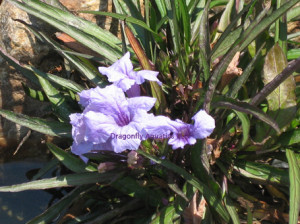 Water bluebells are one of the easiest water plants to grow. They are constantly covered with small, trumpet shaped 2 inch lavender-blue flowers with dark purple-green foliage throughout the growing season. They take sun to part shade and moist soil or water over the crown up to 6 inches deep. They reach 2 - 4 feet and about 24 inches wide. The foliage will turn a burgundy color in the autumn when the temperatures turn cooler.
Water bluebells are one of the easiest water plants to grow. They are constantly covered with small, trumpet shaped 2 inch lavender-blue flowers with dark purple-green foliage throughout the growing season. They take sun to part shade and moist soil or water over the crown up to 6 inches deep. They reach 2 - 4 feet and about 24 inches wide. The foliage will turn a burgundy color in the autumn when the temperatures turn cooler.
I normally will plant my bluebells at the pond's edge near the bog butterfly or water hibiscus to create a bushy colorful area. This is another water plant that will attract butterflies and hummingbirds in your garden.
Buy bluebells, Ruellia brittoniana here.
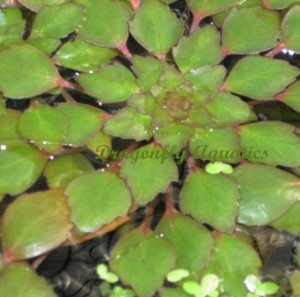 A mosaic plant is a very unique and unusually different marginal water plant that grows mostly as a submerged plant. Its leaves grow from a central radius so that the foliage forms a mosaic like circle. The leaves are green with red edges and stems. The mosaic plant is a attractive plants that quickly provides water coverage in the warm and sunny to partly shady areas of your pond. It prefers water that is not acidic or at least neutral and will die in pond water that is above a pH of 8. It grows best in 12-18 inches of warm water. Make sure your water temperatures are above 65 degrees as the mosaic plant prefers warm water. It is best to anchor the roots in dirt along your pond edge and let it grow out over your pond surface.
A mosaic plant is a very unique and unusually different marginal water plant that grows mostly as a submerged plant. Its leaves grow from a central radius so that the foliage forms a mosaic like circle. The leaves are green with red edges and stems. The mosaic plant is a attractive plants that quickly provides water coverage in the warm and sunny to partly shady areas of your pond. It prefers water that is not acidic or at least neutral and will die in pond water that is above a pH of 8. It grows best in 12-18 inches of warm water. Make sure your water temperatures are above 65 degrees as the mosaic plant prefers warm water. It is best to anchor the roots in dirt along your pond edge and let it grow out over your pond surface.
Its running spread can cover 24 inches and each rosette will spread to 4 inches. During the summer small single yellow flowers will bloom.
The mosaic plant is hardy in zones 8-11 and to winter over in cooler climates needs to be brought indoors and kept in warm water of at least 65 degrees with ample light to stretch.
Buy mosaic plant,Ludwigia sedioides here.
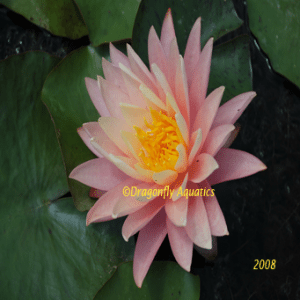 The Barbara Dobbins is a popular hardy water lily. Peach from pale yellow with a deeper pink blush. A truly outstanding lily. Its goblet shaped blooms are about 4-8 inches and has mottled leaves. It will grow to 6-8 feet wide in full sun. It should be planted in 6-24 inches of water and is a good choice for a medium to large pond.
The Barbara Dobbins is a popular hardy water lily. Peach from pale yellow with a deeper pink blush. A truly outstanding lily. Its goblet shaped blooms are about 4-8 inches and has mottled leaves. It will grow to 6-8 feet wide in full sun. It should be planted in 6-24 inches of water and is a good choice for a medium to large pond.
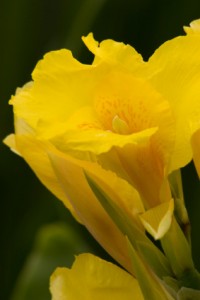 The striped beauty canna has flowers that are white and yellow petals with red stems. Its leaves are a bright green striped in white. It will reach 3-5 feet high and grow 3-4 feet wide. Best if grown in water that is up to 1 inch deep. Hardy in Zones 8 - 11. They cannot withstand a winter freeze. You can bring them indoors for the winter or you can let them dry out so the tubers can be cleaned and stored for the winter. It has been successful taking cannas and placing them in the bottom of your pond for the winter. As long as the rhizomes are not reached by ice during the winter they will return in the spring.
The striped beauty canna has flowers that are white and yellow petals with red stems. Its leaves are a bright green striped in white. It will reach 3-5 feet high and grow 3-4 feet wide. Best if grown in water that is up to 1 inch deep. Hardy in Zones 8 - 11. They cannot withstand a winter freeze. You can bring them indoors for the winter or you can let them dry out so the tubers can be cleaned and stored for the winter. It has been successful taking cannas and placing them in the bottom of your pond for the winter. As long as the rhizomes are not reached by ice during the winter they will return in the spring.
Striped Beauty Canna can be found here.
There are five different types of plants that you will want to add to your pond to provide beauty and help you achieve an ecological balance in your water garden.
Submerged plants such as Anacharis, Vallisneria, Cabomba, Hornwort and Red Ludwigia remove nutrients from the water so algae can’t thrive. Submerged plants do not need soil. Just plant them in one-gallon pots or plant baskets filled with pea gravel and place them in the bottom of your pond. Or purchase plant anchors with your plant order, and simply wrap the weights around the bunch of plants and they will sink to the bottom of the pond.
Water Hyacinth, Water Lettuce, Frog Bit, Parrot’s Feather and Azolla are all members of the floating plant family. Floating plants are very useful in keeping the pond water clean and clear. These are simple plants that free-float and do not need to be potted. You simply toss them into the water garden where they are extremely beneficial to the pond. Floating plants shade the surface and with their roots dangling in the water they pull nutrients from the water essentially starving the algae. They tend to be quite prolific and provide hiding places for baby fish and other water garden inhabitants.
Otherwise known as water lilies, they grow in pots placed 12 to 36 inches deep and have foliage and flowers that bloom on top of the water’s surface. Water lilies provide shade for the fish and add coverage to the water’s surface. Water lilies are available in many different colors and sizes.
Lotus are also considered a hardy water plant that can also be planted deep in your pond and its flowers and leaves will help provide shade and coverage.
Plants such as the hardy canna (Thalia dealbata) grow in mud or 8 to 12 inches deep in the water. Arrange them on platform shelves on the edge of your pond to conceal the water garden’s artificial edges. Plant bog and marginal plants in plastic pots, then place the pot under the water and let the plants grow in the open air. When the plants are young, use care and gradually lower them deeper as the plant matures.
Bog Plants and Marginal Plants
Marginal and bog plants grow in damp soil just outside a pond. They are good transition plants between land and water. Some tolerate completely waterlogged ground and others will not tolerate more than moist soil, check each plant’s requirements carefully.
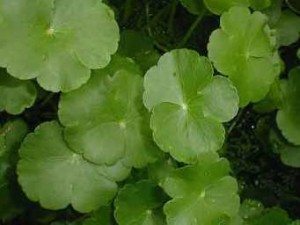 This plant is an excellent water plant for stream beds, bogs or edges of your pond. It grows to about 6"-12" high out of the water and is a fast grower. It leaves are usually shiny and can be anywheres from 3 inches to only 1/2 inch in diameter. This plant is useful in the water garden because of its quick ability to create shade over the pond and grows running stems that will float out over the water surface. It creates a soft edge between water and taller plants such as the cattails, iris or sweet flags.
This plant is an excellent water plant for stream beds, bogs or edges of your pond. It grows to about 6"-12" high out of the water and is a fast grower. It leaves are usually shiny and can be anywheres from 3 inches to only 1/2 inch in diameter. This plant is useful in the water garden because of its quick ability to create shade over the pond and grows running stems that will float out over the water surface. It creates a soft edge between water and taller plants such as the cattails, iris or sweet flags.
It will grow well in sun to part shade and is hardy in Zones 5-11. It grows best in moist soil to water no more than 4 inches deep.
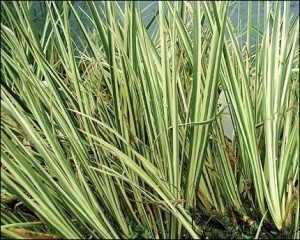 Sweet Flag is a great plant for streams and filters or planted around your ponds edge. It grows to 1-4' tall and is hardy Zones 4-11. It's neat, clear appearance enhances your water feature. The regular variegated sweet flag provides an upright, architectural accent and the dwarf size has a graceful, arching appearance. There are flowers that appear during the summer that are cone-like and appear about one third to halfway up from the base of the foliage sometimes being difficult to find and often go unnoticed.
Sweet Flag is a great plant for streams and filters or planted around your ponds edge. It grows to 1-4' tall and is hardy Zones 4-11. It's neat, clear appearance enhances your water feature. The regular variegated sweet flag provides an upright, architectural accent and the dwarf size has a graceful, arching appearance. There are flowers that appear during the summer that are cone-like and appear about one third to halfway up from the base of the foliage sometimes being difficult to find and often go unnoticed.
Sweet flag grows well in sun to shade and requires soil that is constantly moist, and doesn't like alot of water over their crown. It will tolerate freezing temperatures and even can freeze solid providing they remain in the water while frozen. Your dwarf sweet flag will keep its foliage throughout the winter where the regular sweet flag will lose it foliage during the winter.
Another great evergreen type water plant that adds a clean appearance to your water feature.
Variegated Sweet Flag, dwarf variegated sweet flag found here on our site.
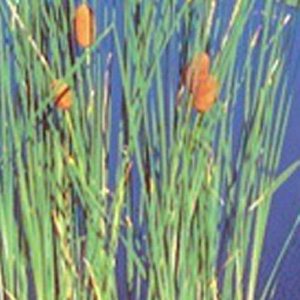 Another form of the cattail is the Dwarf Cattail or 'Typha laxmannii'. It is an ideal hardy bog plant for the smaller ponds and container gardens. Its foliage is very narrow and has small catkins. It will grow to only about 32-36 inches high and is hardy in Zones 3-10. It will grow in sun to part shade in moist soil or water to just 4 inches deep.
Another form of the cattail is the Dwarf Cattail or 'Typha laxmannii'. It is an ideal hardy bog plant for the smaller ponds and container gardens. Its foliage is very narrow and has small catkins. It will grow to only about 32-36 inches high and is hardy in Zones 3-10. It will grow in sun to part shade in moist soil or water to just 4 inches deep.
A good choice for the water gardeners who have container water gardens.
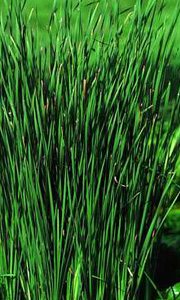 The graceful cattail is exactly that. Graceful as the foliage arches and sways gracefully in the breeze. Its foliage is narrow, from 1/2 inch to 2 inches wide. It height is 4-6 feet and grows in sun to part shade in moist soil or water up to 12 inches deep. It is hardy in Zones 3-11. They overwinter well in cooler water and withstand freezing temperatures. They will tolerate water over their crown. Another thing about cattails is they can be a source of food. The rootstock can be ground into flour, and the new shoots may be boiled and eaten as a vegetable.
The graceful cattail is exactly that. Graceful as the foliage arches and sways gracefully in the breeze. Its foliage is narrow, from 1/2 inch to 2 inches wide. It height is 4-6 feet and grows in sun to part shade in moist soil or water up to 12 inches deep. It is hardy in Zones 3-11. They overwinter well in cooler water and withstand freezing temperatures. They will tolerate water over their crown. Another thing about cattails is they can be a source of food. The rootstock can be ground into flour, and the new shoots may be boiled and eaten as a vegetable.
A graceful cattail's catkins are very thin and can be used in floral arrangements and are quite attractive.